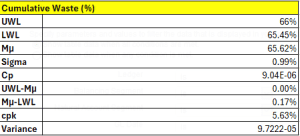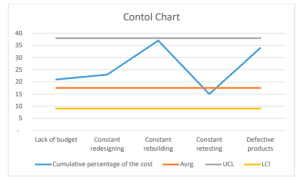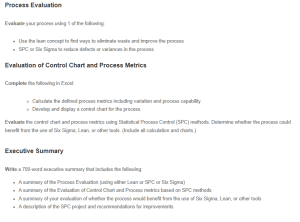Statistical Process Control Methods – Apple Inc
Process Evaluation
| Organizations use the Six Sigma approach to reduce or eliminate flaws in various operations. DMAIC (define, measure, analyze, improve, and control) and DMADV (define, measure, analyze, design, and verify) are the two primary approaches used by Six Sigma. A company’s new procedures depend on the DMADV approach. An organization may gain a lot by integrating Six Sigma into its operations. These include supply chain management, staff motivation, improved time management, shorter cycle times, and strategic planning. Better value, speed, cost-effectiveness, and client happiness are the goals of the technique. Six Sigma puts the client’s demands first during New Product Development (NPD) by enhancing quality and maximizing the company’s financial success. For Apple to gain a competitive edge, its manufacturing method is essential. The company’s method for creating new goods is a response to the ever-changing demands of its customers, who continually need innovation, enhanced technology, greater functionality, and higher product performance. NPD is a procedure that ought to be directed by data gathered from the market via customer interaction. Additionally, product development must move quickly because the average product life cycle is getting shorter.
Most Apple Inc’s flaws in creating new products are seen during the process. First off, clients are not involved in the process from the start. Apple Inc.’s very confidential product development process filters out those not essential to the company’s operation. Clients are necessary, though, as the product was made with them in mind. Second, cutting down on development time is crucial to maintaining a strong competitive edge and ensuring that the new goods require a manageable level of financial resources. Since a budget does not constrain Apple’s designers, their current product development may be described as excessive (Gao, 2021). Simultaneously, there is continuous rebuilding, retesting, and redesigning in case the prototype leaks. Notably, this increases the time and money needed to develop and get a new product into the market. Furthermore, some items are flawed since they don’t meet customers’ expectations, which lowers their market appeal. To enhance this process, Apple Inc. must begin developing new goods based on market data gathered via research and development. While Apple’s devoted customer base has welcomed most of its product debuts, some have disappointed the company. For example, the late Steve Jobs’s desktop computer, NeXT, was viewed as overpriced and fell short of meeting all the demands of the users. Rather than a floppy disk, this machine had an optical drive. Because of this, moving work to the NeXT from another computer was challenging (Wu et al., 2020). Essentially, this demonstrates a lack of dedication to providing customers with precisely what they require, resulting in flaws that render the new product unappealing. |
Evaluation of Control Chart and Process Metrics
| Figure 1: Capability and process variation
Figure 2: Control chart for production of the process The charts demonstrate how numerous wastes occur across Apple Inc.’s production process, undermining the company’s competitive edge. The existence of a point outside the control boundaries indicates a waste. The control chart indicates that frequent redesigns and a lack of budgeting are not significant causes of waste since they fall under the control boundaries. Retesting often stays inside the control range. Notably, this demonstrates that, far from being a waste, retesting is an essential stage in the production process since it helps the testing teams make sure the company’s goods meet authorized criteria. Continuous retesting may need a little improvement, but more sophisticated technology may be needed to boost production efficiency. As a result, continuous redesigning exceeds the control limit and necessitates improvement techniques. Not only does redesigning lengthen the time customers must wait for products, but it also uses more resources, eventually reducing the company’s profitability. Still, ongoing revamping is a necessary task in the production process. Testing teams may benefit greatly from illustrative product design evaluation by receiving critical input that allows them to modify the program to better meet consumer needs before market release, increasing competitiveness. In the future, frequent remodelling will significantly exceed the control boundaries. Considerable waste results from Apple’s endeavour to maintain quality by designing its products according to client demands. |
Executive Summary

Process Evaluation SummaryApple Inc.’s NPD process review makes use of the Six Sigma technique. The DMAIC and DMADV methodologies are used in the Six Sigma methodology. The DMADV method is particularly crucial for the creation of new products. In this instance, the flaws that are being addressed include process delays, exorbitant expenses, and goods that fall short of market demands. Apple Inc. continues to be a premium brand leader in the market while continuing to manufacture goods simultaneously. Loyal customers keep an eye out for these freshly introduced offerings. However, because it is not specified, the development period is flawed. Owing to the leaks from prototypes, it can be expanded. Because of the short product life cycle of today’s products, this results in the usage of greater financial resources and time. Companies like Apple must not just continually release new items but also ones that cater to the market’s shifting demands, as products become outdated quickly. Customers’ demands are not given enough consideration in Apple’s development process. While the business may leverage consumer purchasing patterns for research and development, finding a product that meets customers’ expectations might be difficult. Client input is, therefore, crucial. Notably, this will encourage acceptance and allegiance from the target demographic and lessen or stop the creation of substandard items. Moreover, there is a need to restrict the resources allotted to NPD. As was mentioned above, creative financial resource management is required to guarantee large returns on every investment. It is expensive to devote all your efforts to new product development (NPD) only to have small sales because of a flaw that reduces the product’s usefulness, efficiency, and marketability. Evaluation Control SummaryThe assessment control charts demonstrate that redesigning, retesting, and not having a budget does not always equate to resource waste. These actions are critical to guaranteeing the competitiveness and defect-free nature of the company’s products. Since the product’s functionality needs to be confirmed, retesting is essential. Nonetheless, it is critical to assess the new items using cutting-edge technology. Essentially, this ought to greatly increase the business’s efficiency. Lead times rise when items must go through the design process more than once. More resources are used during this period that might not be recouped via the product’s sale. Six Sigma EffectivenessApple Inc. must try to enhance the design procedure. The company’s product development process has been evaluated, and it’s crucial to highlight that the Six Sigma approach can make major improvements. The technique aims to make businesses create their goods with customers in mind, as was previously said. Considering the wants of the clientele may entail doing direct surveys, looking over customer input, and going over concepts that the R&D division has gradually found. By looking for this kind of information, the business may learn about its clientele’s preferences and unmet needs. They may then incorporate these ideas into the design and functioning of the new product. This method saves money and lessens the possibility that the product must be rebuilt or redesigned. Retesting is still a necessary component, though, as it is vital to getting rid of flaws. The business might involve the clients in this procedure for more useful input. The Six Sigma approach has promise as it may revolutionize the process of developing new products, save expenses for the organization, and minimize any wastage that may arise. As a result, it is worth it for Apple Inc. to embrace the Six Sigma approach and adopt it in its product development processes. Improvement RecommendationsAdding a few extra processes to Apple’s present product development process is critical to enhance it. Putting together a team, establishing objectives and a vision, assessing customer feedback, examining R&D discoveries and innovations, choosing the right product, assigning an adaptable budget and schedule, debugging the product, and modifying it to satisfy market demands are some of the primary enhancements. These modifications align with the Six Sigma technique, which aims to guarantee that the product is built within a flexible budget and satisfies the demands of the clients. After manufacturing, troubleshooting enables the business to find flaws customers could notice while utilizing the new product. It is anticipated that this development method would lessen any flaws and other irregularities that could appear when the product is launched. Establishing goals and a shared vision enables the team to comprehend the project’s course and contribute to its realization. The company’s goals are significant since they give the team members a direction to follow. They reduce internal opposition by directing the team members in a specified direction. A well-defined objective streamlines the entire procedure and improves the likelihood of reaching the intended result. |
References
Gao, J. (2021). Analysis of the Diversification strategy of Apple Inc. Academic Journal of Business & Management, 3(9), 34-39.
Wu, R., Wang, C. L., & Hao, A. (2020). What makes a fan a fan?: The connection between Steve Jobs and Apple fandom. In Handbook of Research on the Impact of Fandom in Society and Consumerism (pp. 378-396). IGI Global.
Evaluate your process using 1 of the following:
- Use the lean concept to find ways to eliminate waste and improve the process
Statistical Process Control Methods – Apple Inc
- SPC or Six Sigma to reduce defects or variances in the process
Evaluation of Control Chart and Process Metrics
Complete the following in Excel:
-
- Calculate the defined process metrics including variation and process capability.
- Develop and display a control chart for the process.
Evaluate the control chart and process metrics using Statistical Process Control (SPC) methods. Determine whether the process could benefit from the use of Six Sigma, Lean, or other tools. (Include all calculation and charts.)
Executive Summary
Write a 700-word executive summary that includes the following:
- A summary of the Process Evaluation (using either Lean or SPC or Six Sigma)
- A summary of the Evaluation of Control Chart and Process metrics based on SPC methods
- A summary of your evaluation of whether the process would benefit from the use of Six Sigma, Lean, or other tools
- A description of the SPC project and recommendations for improvements



